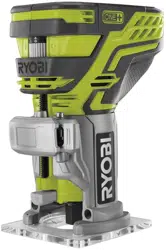Loading ...
Loading ...
Loading ...

9
WARNING
Avoid hand positions that may expose ngers to bit
through open areas of trimmer base. Fingers entering
the opening in the trimmer base can be seriously cut or
burned.
CAUTION
To avoid damaging the motor from overheating, do not
let your hand cover the air vents.
STARTING/STOPPING THE TRIMMER
See Figure 6.
To turn the trimmer ON (I), slide the switch on front of the
trimmer to the ON (I) position. Return the switch to the OFF
(O) position when nished.
OPERATING THE TRIMMER
Before starting the trimmer, with the battery pack
disconnected, make sure the bit is securely tightened in the
collet and that the depth of cut is properly set. Never start
the trimmer while the bit is in contact with the workpiece.
After completing a cut, pull the bit slightly away from the cut
surface. Turn the trimmer off and wait for the rotating bit to
completely stop before completely removing the tool from
the work surface.
When cutting, locate the base of the trimmer over the work
surface and rmly hold the body of the trimmer with your
hand. Make sure the trimmer is running at full speed before
contacting the workpiece.
DIRECTION OF FEED AND THRUST
See Figures 7 - 8.
The trimmer motor and bit revolve in a clockwise direction.
This gives the tool a slight tendency to twist in your hands
in a counterclockwise direction, especially when the motor
starts.
Feed the trimmer into the workpiece from left to right. When
fed from left to right, the rotation of the bit pulls the trimmer
against the workpiece. If fed in the opposite direction, the
rotation forces of the spinning bit will tend to throw the
trimmer away from the workpiece, causing kickback. This
could result in loss of control of the trimmer.
Because of the extremely high speed of bit rotation during
a proper feeding operation, there is very little kickback to
contend with under normal conditions. However, should the
bit strike a knot, hard grain, foreign object, etc. that would
affect the normal progress of the cutting action, there will
be a slight kickback. Kickback could be sufcient to spoil
the trueness of your cut if you are not prepared. Such a
kickback is always in the direction opposite the direction
of bit rotation.
To guard against kickback, plan your set-up and direction
of feed so that you will always be thrusting the tool—to hold
it against whatever you are using to guide the cut—in the
same direction that the leading edge of the bit is moving. The
thrust should be in a direction that keeps the sharp edges
of the bit continuously biting straight into new (uncut) wood.
SETTING DEPTH OF CUT
See Figure 9.
■ Turn the switch off and remove the battery pack from
the trimmer.
■ Open the depth adjustment latch as indicated by the
arrow.
■ Slide the motor housing section of the trimmer upward
until the tip of the bit reaches the work surface. The
depth of cut is zero at this point.
■ Adjust the position of the trimmer to obtain the desired
depth of cut by moving the motor housing section up or
down, as shown by the up/down arrow. The distance
the bit moves can be read on the depth of cut scale.
Each mark on the scale indicates a 1.6mm (1/16”)
change in depth setting. Indicator points are located on
the base.
■ Completely close the depth adjustment latch.
WARNING
Avoid open area of trimmer base. Serious personal
injury will result from contact with a rotating bit.
NOTE: To make deeper cuts, it is necessary to make as
many successive passes as required, lowering the bit
3.18mm (1/8”) for each new pass. To save time, perform all
the cutting necessary at one depth setting, then lower the
bit for the next pass. This will assure uniform depth when
the nal pass is completed.
WARNING
Do not use straight bits larger than 6.35mm (1/4”) or
edging bits which cut a pattern larger than 9.53mm (3/8”)
with this trimmer. Use of larger bits can result in loss of
control and serious personal injury.
WARNING
Never install a bit larger than the opening of the trimmer
base. The use of larger bits can result in loss of control
and possible serious personal injury.
WARNING
If the desired depth of cut is greater than can be safely
cut in one pass, make cuts in two or more passes. Do
not remove more than 3.18mm (1/8”) in a single pass.
Excessive depth of cut can result in loss of control and
the possibility of serious personal injury.
PROPER RATE OF FEED
Trimming and edge shaping depend upon careful set-up
and selecting the proper feed rate.
The proper feed rate is dependent upon:
■ The hardness and moisture content of the workpiece
■ The depth of cut. It is necessary that you do not exceed
3.18mm (1/8”) depth of cut for proper rate of feed.
Loading ...
Loading ...
Loading ...
